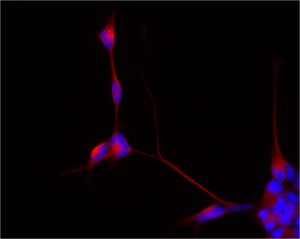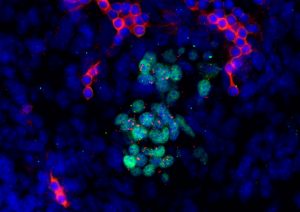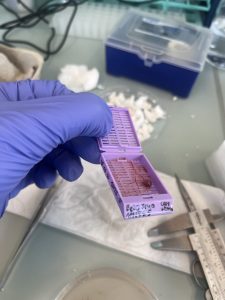Neuroblastoma (NB) is a pediatric malignancy of the sympathetic nervous system (SNS), which is one of the deadliest solid tumors in childhood despite highly invasive multimodal treatments. The hallmark of NB is its high heterogeneity, both genetically and biologically, which is reflected in the clinical outcome, ranging from spontaneous regression to an extremely aggressive disease with fatal outcome for 50% of patients with high-risk NB.
The Neuroblastoma Research group has a long-standing interest in the biology and genetics of NB, and more recently focused on the early events underpinning NB tumorigenesis, which remains poorly understood. NB is presumed to originate from abnormal differentiation of neural crest progenitor cells of the sympathoadrenal lineage. Despite recent progress in the understanding on the developmental origin of NB, data are still lacking regarding how a driver mutation disrupts the normal development of the originating tissue. The anaplastic lymphoma kinase (ALK) and the transcription factor TWIST1 are developmental genes reactivated in various cancer settings through genetic alterations or deregulation. Our current interest is to elucidate their implication on NB tumor initiation and progression. Our long-term goal is to develop new and effective therapies for patients with high-risk relapsed or refractory NB.
We are also involved in translational research projects of the European SIOPEN Biology group aiming to better integrate genomic, biologic, and clinical data to best refine risk-stratification and treatment strategies to improve NB patient outcome.

Project 1#: Involvement of ALK deregulated signaling on NB tumor initiation and progression.
ALK represents the most frequently mutated gene in NB, and this corresponds to a predisposing event in NB. To improve our comprehension of the precise role for ALK deregulated signaling in the initial steps of NB genesis, we recently investigated the impact of the human ALK-F1174L mutation on the development and differentiation of the SNS. Using genetically engineered mouse models (Sox10-Cre;LSL-ALK-F1174L), we revealed that ALK-F1174L expression in migrating neural crest cells during embryonic development profoundly disturbs early sympathetic, neuronal and noradrenergic differentiation of sympathetic progenitors, in addition to increasing their proliferation, both mechanisms being potential crucial events in NB oncogenesis (Vivancos, L. et al. Front. Oncol. 2019 9:275).
Our research strategy is to combine genetic and developmental biological approaches with single-cell RNA sequencing technology to characterize in detail the cellular and molecular alterations induced by ALK activating mutations in the developing SNS. The results of our investigations will enhance our understanding of the mode of action of a driver mutation leading to tumorigenesis, as well as the mechanisms disrupting the tight regulation between proliferation and differentiation in the SNS during embryogenesis. The molecular pathways altered by ALK mutations in these processes may represent new targets for the development of innovative therapies.

Project #2: Deciphering the role of TWIST1 in high-risk neuroblastoma
To improve the outcome of high-risk NB patients, the identification of novel key players involved in NB pathogenesis and progression is crucial. The expression of the TWIST1 oncogene in primary NB is preferentially associated with unfavorable prognostic factors of NB, such as MYCN amplification (MNA), and reduced survival. However, an elevated expression of TWIST1 in low-risk tumors or NB without MNA is also correlated with poor outcome. We recently revealed the decisive contribution of TWIST1 in the context of MYCN amplified NB, as it enhanced primary and secondary tumor growth and mediated a remodeling of the tumor microenvironment (TME) in favor of tumor progression. This confirmed TWIST1 as a valuable therapeutic target for HR-NB (Sepporta et al., Communications Biology. 2022).
Our research effort focusses now at elucidating the functional role played by TWIST1 in non-MNA NB. For this purpose, in vivo studies are performed to evaluate the role of TWIST1 on tumor growth, metastatic dissemination, and TME organization. Moreover, to characterize the molecular mechanisms underlying TWIST1 functions, transcriptomic analyses will be performed on the resulting tumors to obtain a genome-wide characterization of the gene expression program altered by TWIST1 in vivo in absence of MNA. We also plan to characterize the proteins interacting with TWIST1 or its target genes that are required for its function, both in presence and absence of MYCN. The knowledge gained from this study will significantly contribute to improve our knowledge on TWIST1 role in NB pathogenesis and should open new avenues to design innovative therapeutic options that are urgently needed for children with high-risk NB.
Project #3: Establishment of the CAM assay as an alternative in vivo assay to study various aspect of NB biology.
The chicken embryo chorioallantoic membrane (CAM) assay is a recognized alternative to mouse models for studying tumor growth, metastatic dissemination, angiogenesis, drug response or cellular metabolism. Because the CAM is highly vascularized and naturally immunodeficient, it enables efficient grafting of tumor cell lines or patient-derived xenografts, and rapidly promotes metastasis. The CAM assay therefore represents an alternative in vivo model for investigating various hallmarks of cancer while applying the 3R guidelines. To establish and validate this model, tumor morphology and heterogeneity, as well as various biological properties will be evaluated by histological and transcriptomic analyses and compared to tumors obtained from subcutaneous or orthotopic implantations in mice. Once set up, this in vivo model will be a valuable tool for analyzing of various aspect of NB biology as well as for evaluating of novel drug combinations.


